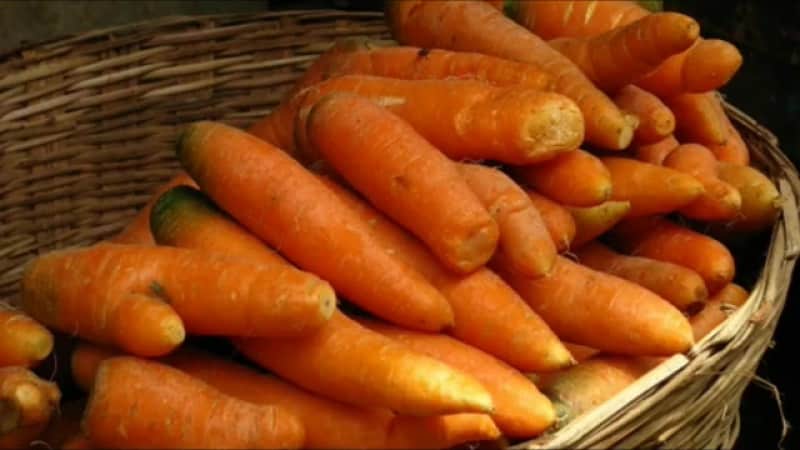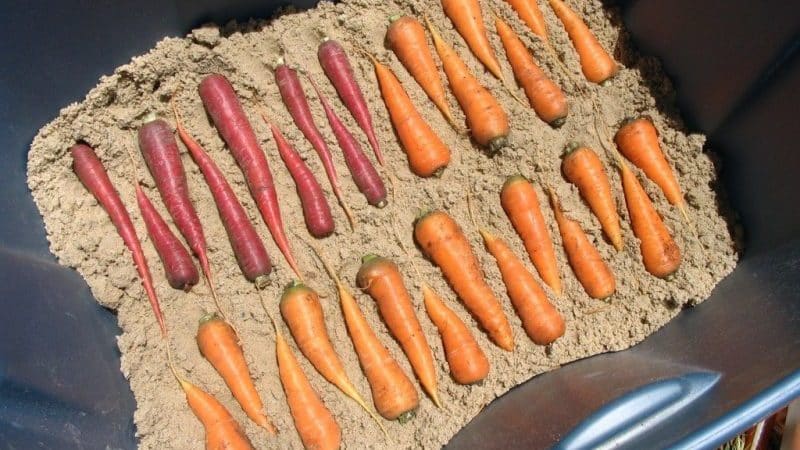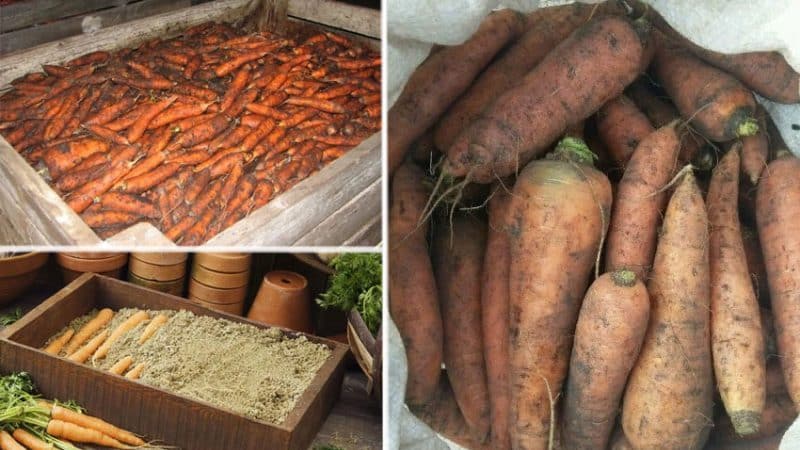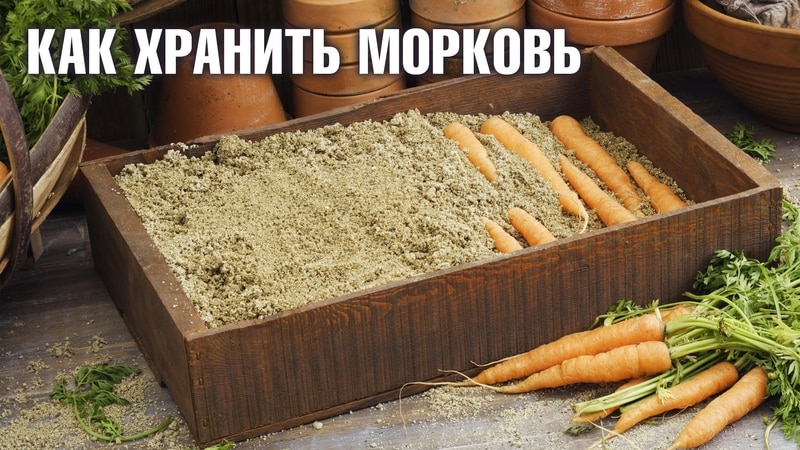Features of storing carrots at home in an apartment
Preserving carrots is as difficult as growing them. Improper storage, especially in an apartment, can quickly destroy the crop.
How to properly store carrots at home in an apartment so that they do not lose their freshness and taste?
Preparation for storage
There are five main problems that are commonly encountered when storing carrots improperly:
- withering;
- germination;
- rotting;
- change in taste;
- loss of beneficial properties.
To avoid them, carrots are carefully prepared for storage. Harvest only in good, dry weather. To ensure that the root crops are moderately juicy and do not crack, they should not be watered for three days before harvesting. If the soil is hard and dry, the plants are usually dug up a little with a shovel.
It is very important not to damage the root crops when harvesting. Therefore, they are not pulled, but carefully pulled out of the ground by the tops. I immediately cut off the topst, because it takes water from the vegetable. Leave a stump of 2-3 mm. The collected carrots are laid out to dry for 1-2 hours.
Early ripening varieties are best suited for long-term storage. Unlike late-ripening ones, by autumn they have time to ripen and accumulate enough sugar and fiber. Tender varieties should be avoided. These are optimal for long-term storage varieties, like the Queen of Autumn, Carlena, Samson and Vitamin.

Important! If you buy carrots in a store and it is impossible to determine the variety, rely on its appearance.Medium-sized and conical-shaped root vegetables are best stored.
After harvesting, the carrots are sorted, leaving vegetables for storage without traces of rot, disease, cuts or damage from insects. If you come across one spoiled root crop, it will subsequently infect all the others.
Opinions differ on whether it is worth washing carrots in advance. Some people believe that washing under running water helps get rid of fungus and infection. But practice shows that washed vegetables last as long as dirty ones. In addition, when cleaning there is a risk of damaging root vegetables, and this will significantly reduce their shelf life.
After washing for several hours, the vegetables are dried. Do not leave them in the sun or raise the temperature above room temperature, otherwise they will begin to wither. It is recommended to cool carrots to 0°C for two days. This is done either immediately after drying, or immediately before laying.
You cannot cut carrots for long-term storage. A vegetable with damaged skin will spoil much faster than a whole one. That is why you cannot cut off the tail and base of the root crop. The only exception is freezing. In this case, the carrots are usually grated.
For storage, choose a dry room with an air humidity of 90-95% and a temperature of +1...+3°C. It is also advisable to disinfect containers for vegetables.
Important! Carrots should not be stored together with other vegetables, especially apples. They emit ethylene, which causes root vegetables to spoil faster.
Storing carrots in the apartment

In private homes, there are usually no problems with storing crops. But city apartments are not suitable for this. If potatoes normally lie on an insulated balcony in a container protected from the sun, then carrots cannot be stored like that.
Although it is difficult to ensure the safety of carrots throughout the winter at home, you can still create suitable conditions in your apartment.
It is best to use a balcony or glassed-in loggia for storing large quantities of vegetables. There you can maintain the desired temperature, and also place much more vegetables. There they equip wooden boxes insulated with foam plastic or use a thermal cellar.
Carrots are extremely sensitive to negative temperatures. Even short freezing causes loss of freshness and juiciness, and some areas may become covered with mucus when thawing. Therefore, it is important to closely monitor the temperature.
Attention! To monitor the temperature, place thermometers inside the drawers where carrots are stored.
Fridge has advantages over balcony storage - constant temperature and humidity. Modern refrigerators are equipped with special chambers for storing vegetables, where the temperature is maintained at about +2°C. They allow you to store carrots for a long time. It is better to use cling film, wrapping 1-2 root vegetables together.
Some owners prepare carrots in the freezer. To do this, unlike other methods, the carrots are thoroughly washed and peeled. After that, it is crushed, packaged in bags and placed in the freezer. But with such storage, the taste and most of the vitamins are lost.
What's the best way to store carrots?

There are several ways to store carrots. For many of them it is a must have in the house cellar, but some are quite feasible in a city apartment.
In a refrigerator
A small amount of vegetables is stored in the refrigerator, placed in regular or vacuum plastic bags. This method is only suitable for short-term storage, since carbon dioxide accumulates in a tightly closed bag, causing root vegetables to spoil. If you make holes in the bag, the process of withering will soon begin due to loss of moisture.
Vacuum and cling film are considered very effective packaging methods for the refrigerator and freezer. Thanks to them, moisture does not evaporate from root crops and does not penetrate from the outside. It is best to wrap each root vegetable separately in film.
In the freezer
If there are only a few carrots, they are peeled, grated or chopped in a food processor and placed in the freezer. To do this, use plastic bags or plastic containers.
In clay
An effective way is to store it in clay.. Clay is diluted with water to the consistency of liquid sour cream and root vegetables are dipped in it. They are dried and placed in plastic bags or boxes. There is no need to tie the bags. The thin clay crust allows vegetables to be stored for a very long time. It perfectly protects against dampness, allows air to pass through and prevents bacteria from multiplying.
In paper packaging
Paper packaging, such as cardboard boxes, is also suitable for storage. For better preservation, carrots are placed in them together with horseradish in a ratio of 20:1. Horseradish contains essential oils that, when released, fight mold and mildew. The boxes must be closed.
In boxes with onion peels
Onion skins are often used as an alternative to horseradish. Carrots are placed in boxes in layers, each layer is sprinkled with peels so that the vegetables do not come into contact with each other. In this form, root vegetables can be stored for a long time, but there is a risk that after some time they will begin to wither.
In sawdust
Sawdust, especially coniferous sawdust, is very good as a filler. They absorb excess moisture and release essential oils that have an antiseptic effect.
In wet sand

Many people use damp for storage. sand. Carrots are laid out in boxes in layers and sprinkled with sand. If there are no severe frosts, it will last until spring. This method will help preserve carrots, beets and other vegetables in your apartment for the winter. Such boxes are sometimes placed not only on the balcony, but also in the common corridor, if possible.
In paraffin
Paraffin is sometimes used for storage. The carrots are washed, dried and dipped in molten paraffin. It is recommended to add a little beeswax to it for elasticity. This method is very effective. It allows you to preserve the pristine freshness of carrots and their taste for a long time. During storage, it is important to ensure that the temperature does not exceed +2°C.
In the heating cabinet
A device called a heating cabinet is gaining popularity among gardeners. It automatically maintains the desired temperature and can hold a volume of up to 300 liters. This device, similar to a large bag, is placed both on the balcony and inside the apartment.
Shelf life of carrots in an apartment
In the refrigerator at a temperature of 0...+3°C, fresh carrots can be stored for 1-3 months in a plastic bag or container. This only applies to whole root vegetables. Grated vegetables are stored for an average of 10-12 days, after which they become weathered and begin to wither.
Frozen carrots are stored significantly longer: at a temperature of -8...-20°C - 9-12 months. But it is worth remembering that when freezing and thawing, the benefits remain minimal.
If root vegetables are stored in a bag or unpacked at room temperature, they remain usable for no more than two months. After this, the carrots wither, and putrefactive processes develop in damaged vegetables.
Carrots are stored the longest at a temperature of 0...+2°C in a wooden box filled with pine sawdust. Vegetables prepared in this way can be stored for a whole year if there are no fluctuations in temperature and humidity. In urban conditions, even on a glazed balcony, this is usually not possible to achieve. The solution is to use a thermal cellar.
Sand, clay and airtight packaging are slightly less effective for storage. They allow you to preserve root crops for a period of 5-9 months.
Paraffin leaves almost all the properties of carrots and their presentation unchanged for 4–5 months.
Important! Even if all storage conditions are strictly observed, carrots must be checked 2-3 times a month and lethargic and rotten specimens removed.
Let's sum it up
Carrots are finicky when stored, and, unfortunately, an apartment is not the best place for them. However, there are still ways to “house” vegetables - from traditional refrigerators to thermal cellars and enveloping them in paraffin or clay. The choice depends on the volume of the harvest and the availability of time.